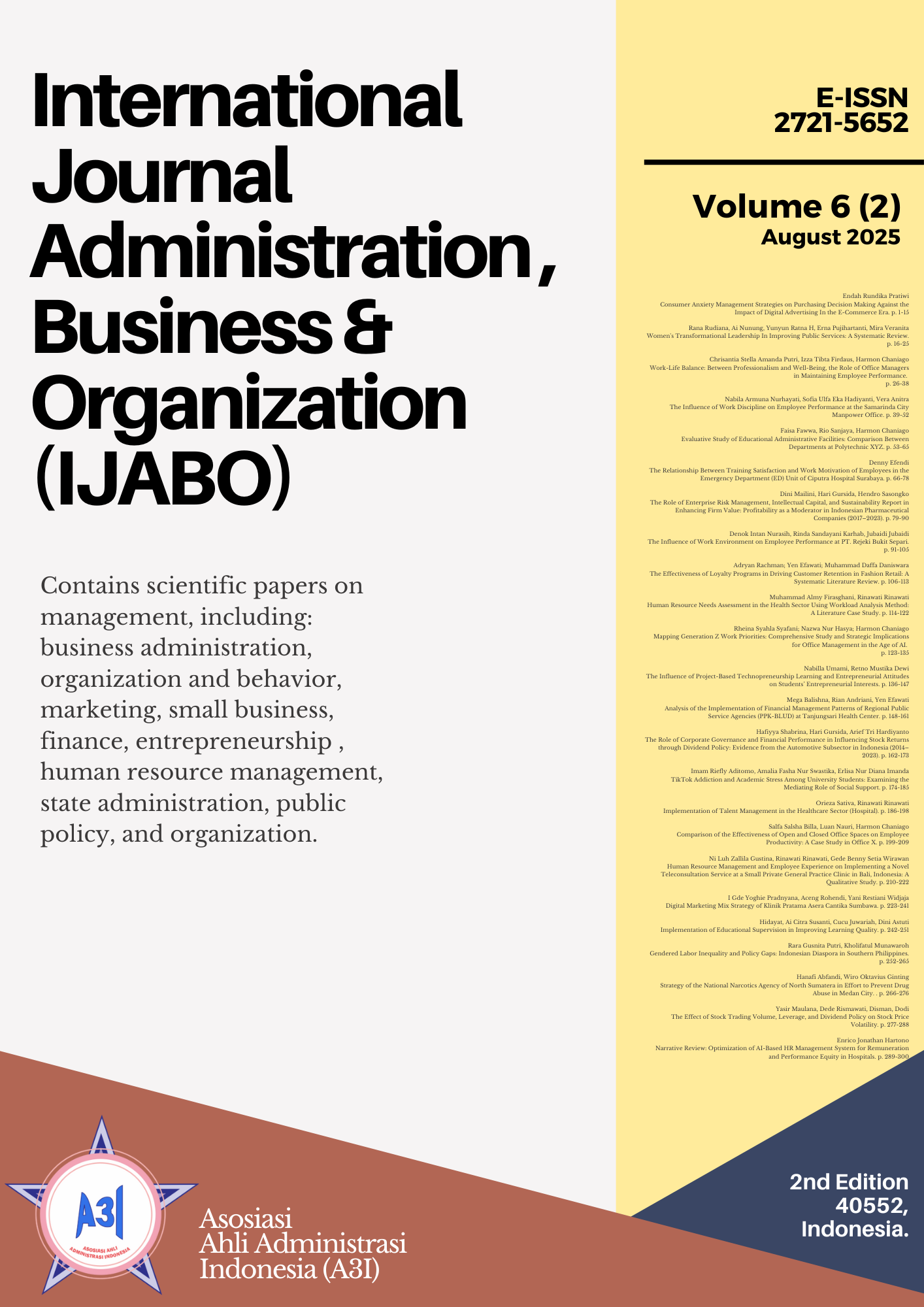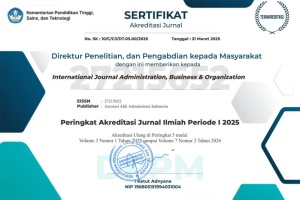Comparison of the Effectiveness of Open and Closed Office Spaces on Employee Productivity: A Case Study in Office X
Abstract
This study compares the effectiveness of open and closed office spaces in the Office Using direct observation and in-depth interviews, the study found that open spaces encourage collaboration and communication, although they can reduce privacy and increase noise. Meanwhile, closed spaces provide greater focus and privacy, ideal for individual tasks and confidential meetings. The findings suggest that a hybrid approach combining both layouts offers the most effective solution to accommodate a variety of work needs. Theoretically, this study highlights the importance of integrating psychological and task-based considerations in workspace design. Practically, it informs organizations about the value of flexible, activity-based office layouts that align with employees’ work styles. The novelty of this study lies in its context-specific analysis that combines observational data with user experiences, offering a more holistic perspective than previous research that often focuses on one type of layout. This highlights the need for adaptable office design to support employee well-being and productivity.
References
Abdilah Kurniawan, L. (2020). Investigasi Pengaruh Lingkungan Kerja pada Produktivitas Kerja Karyawan Investigation of The Influence of Working Environment on Employee’s Work Productivity. International Journal Administration, Business and Organization (IJABO) |, 1(3), 47–53. https://ijabo.a3i.or.id
Ambia. (2018). 339-662-1-Sm. Pengaruh Efektivitas Kerja Pegawai Terhadap Kualitas Pelayanan Publik Di Kelurahan Sidorame Barat I Kecamatan Medan Perjuangan, 1, 214–262.
Anggraeni, W., & Yuniarsih, T. (2017). Dampak Tata Ruang Kantor Terhadap Efektivitas Kerja Pegawai Dinas Pendidikan Kota Bandung. Jurnal Pendidikan Manajemen Perkantoran. https://doi.org/10.17509/jpm.v2i2.8098
Apriyanto, W., Achmad Fauzi, Hasanuddin, H., Yonathan Langi, Yoga adrian Aldiyansyah, & Sendy wijaya. (2023). Pengaruh Budaya Organisasi dan Desain Kerja Terhadap Kinerja Karyawan (Artikel Manajemen Kinerja). Jurnal Ilmu Multidisplin, 1(4), 846–853. https://doi.org/10.38035/jim.v1i4.140
Ardhya, R. (2014). Pengaruh Tata Ruang Kantor Terhadap Kinerja Karyawan PT . Tempo Group Cabang Group Cabang Surabaya 2. Administrasiperkantoran, Prodi Pendidikan.
Aryadi, T. (2020). Analisis Efektifitas Kerja Pegawai. In CV. Elsi Pro.
Baiti, K. N., Djumali, D., & Kustiyah, E. (2020). Employee Productivity Viewed from Motivation, Work Discipline, and Environment at PT. Iskandar Indah Printing Textile Surakarta. Jurnal Ilmiah Edunomika, 4(01), 69–87.
Bernstein, E. S., & Turban, S. (2018). The impact of the ‘open’ workspace on human collaboration. Philosophical Transactions of the Royal Society B: Biological Sciences, 373(1753). https://doi.org/10.1098/rstb.2017.0239
Creswell, J. W. (2015). Note de lecture : Qualitative inquiry and research design . Choosing among five approaches ( 3 e éd .). London : Sage . Research Gate, 1(November), 4.
De Been, I., & Beijer, M. (2014). The influence of office type on satisfaction and perceived productivity support. Journal of Facilities Management, 12(2), 142–157. https://doi.org/10.1108/JFM-02-2013-0011
Efawati, Y. (2020). The influence of working conditions, workability and leadership on employee performance. International Journal Administration, Business & Organization, 1(3), 8-15. https://doi.org/10.61242/ijabo.20.40
Febrian Valentino, & Widwi Handari Adji. (2023). Pengaruh Beban Kerja Terhadap Efektivitas Kerja Karyawan Di Dinas Perdagangan Kota Bandung. E-Bisnis : Jurnal Ilmiah Ekonomi Dan Bisnis, 16(2), 376–380. https://doi.org/10.51903/e-bisnis.v16i2.1332
Haris, R. M., & Lestariningsih, M. (2024). Analisis Tata Ruang, Lingkungan Kerja Fisik, Dan Fasilitas Kantor Terhadap Kinerja Karyawan. Jurnal Ilmiah Manajemen Dan Bisnis (JIMBis), 3(2), 154–173. https://doi.org/10.24034/jimbis.v3i2.6682
Himma, O. M. (2020). Analisis pengaruh faktor lingkungan kerja dan budaya organisasi terhadap kinerja karyawan. 14.
HOK. (2023, Januari 09). 9 Workplace Design Trends for 2023. Retrieved from hok.com: https://www.hok.com/news/2023-01/9-workplace-design-trends-for-2023/
Indayani, L. (2018). Pengantar Manajemen. In Pengantar Manajemen. https://doi.org/10.21070/2018/978-602-5914-18-8
Kim, J., & de Dear, R. (2013). Workspace satisfaction: The privacy-communication trade-off inopen-plan offices. Journal of Environmental Psychology, 36, 18–26. https://doi.org/10.1016/j.jenvp.2013.06.007
Krisnandi, H., Efendi, S., & Sugiono, E. (2019). Pengantar Manejemen. Jakarta Selatan: LPU-UNAS.
Leesman. (2020). The world’s best workplaces 2019: Unpacking lessons from the top. 58.
Leuhery, F., Padang, N. S., Puspitasari, D., & Judijanto, L. (2024). Workplace Diversity and Inclusion : Strategies for Effective Implementation and Benefits to Organizational Culture. 5(4), 4647–4653.
Muharam, D. A., & Nurdin, B. (2020). Evaluasi Pelatihan, Motivasi, Insentif dan Pengaruhnya pada Kinerja Karyawan (Training Evaluation, Motivation, Insentive, and its Influence on Employee Performance). International Journal Administration, Business and Organization (IJABO) |, 1(1), 32–40. https://ijabo.a3i.or.id
Purbandini, P., & Ninghardjanti, P. (2025). Pengaruh tata ruang kantor dan fasilitas kantor terhadap kinerja pegawai Badan Kepegawaian dan Pengembangan Sumber Daya Manusia ( BKPSDM ) Kota Sura karta Pendahuluan. 9(1), 86–93.
Putri P, M. M. (2019). Pengaruh Tata Ruang Kantor, Lingkungan Kerja, Kualitas Sumber Daya Manusia Dengan Fasilitas Kantor Sebagai Variabel Moderating Terhadap Kinerja Pegawai Di Dinas Komunikasi Dan Informatika Provinsi Jawa Tengah. 1–56.
Santosa, H. D., Manulang, L., & Putri, S. K. (2022). Integrating Diversity and Inclusion in Organizational Culture: A Holistic Approach to People Management. Jurnal Office, 8(2), 385. https://doi.org/10.26858/jo.v8i2.45363
Satyagraha, J., Munir, M., Manajemen, P. S., Ekonomi, F., Sunan, U., Surabaya, G., Organisasi, K., & Kerja, E. (2024). Organisasi terhadap efektivitas kerja karyawan. 06(02), 231–248.
Soetiksno, A., Wijaya, F., & Akasian, I. (2023). Pengaruh Tata Ruang Kantor Terhadap Kinerja Pegawai Pada Kantor Bappeda Litbang Kota Ambon. Jurnal Administrasi Terapan, 2(2), 394–406.
Sutriani, & Hamdiah. (2022). Analisis Efektivitas Kerja dan Tata Ruang. Jurnal Visioner & Strategis, 11(1), 55–59.
Yusen, S. I. S. (2014). Pengaruh Tata Ruang Kantor Terhadap Kinerja Karyawan Bagian Tata Usaha di SMPN 1 Lamongan. Jurnal Pendidikan Administrasi Perkantoran, 2, 1–15. https://jurnalmahasiswa.unesa.ac.id/index.php/jpap/article/view/9324
Copyright (c) 2025 Salfa Salsha Billa, Luan Nauri, Harmon Chaniago

This work is licensed under a Creative Commons Attribution-ShareAlike 4.0 International License.
Authors who publish in this journal agree to the following terms:
- The authors confirm that they are the authors of the submitted article, which will be published (online) in the journal IJABO (International Journal Administration, Business & Organization) by the Asosiasi Ahli Administrasi Indonesia (A3i), Bandung, Indonesia. The author’s name will be evident in the article. The publisher makes all decisions regarding the layout and distribution of the work.
- Authors guarantee that the work is their own original creation and does not infringe any statutory or common-law copyright or any proprietary right of any third party. In case of claims by third parties, authors commit themself to defend the interests of the publisher and shall cover any potential costs.
- Authors retain copyright and grant the journal the right of first publication, with the work simultaneously licensed under a Creative Commons Attribution-ShareAlike 4.0 International License (CC BY-SA 4.0). This license allows the redistribution and reuse of papers provided the authorship is properly credited.
- Authors can enter into separate, additional contractual arrangements for the non-exclusive distribution of the journal's published version of the work (e.g., posting it to an institutional repository or publishing it in a book), with an acknowledgment of its initial publication in this journal.
- Authors are permitted and encouraged to post their work online (e.g., in institutional repositories or on their website) prior to and during the submission process, as this can lead to productive exchanges and earlier and greater citations of published work.

















